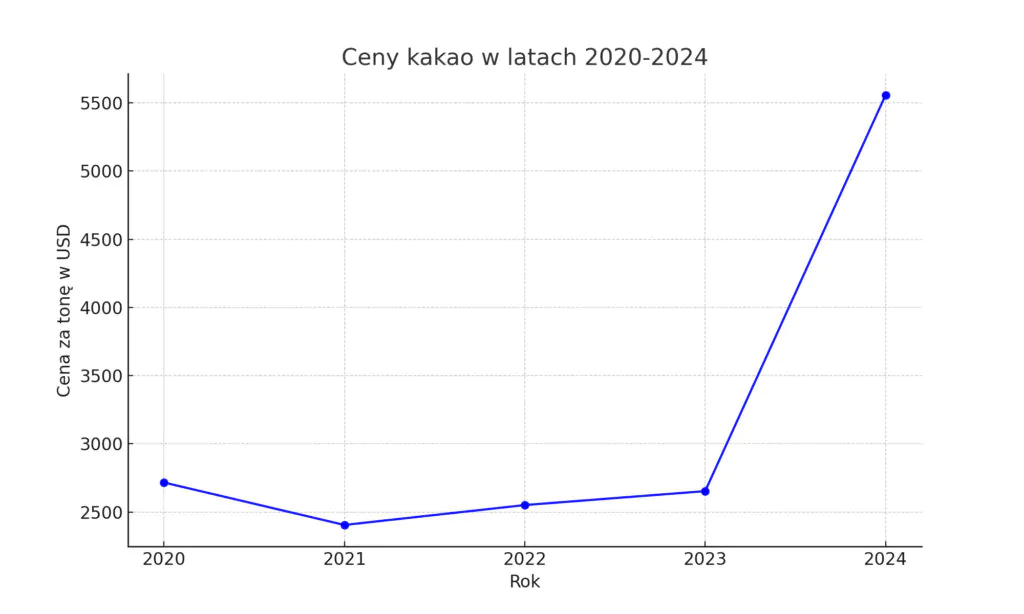Business and economics, Issue 7/2024
Luxury chocolate hare. Cocoa prices break records
In the past year we have seen an unprecedented increase in the price of cocoa on world markets, which directly affects the price of chocolate and products made from it. This trend is causing concern among both producers and consumers of sweet products. Will cocoa prices soon make the chocolate Easter bunny a luxury available only to a select few?
Major cocoa producers
Cocoa cultivation is mainly concentrated in areas with tropical climates, where natural conditions are favorable for growing cocoa trees. More than 70 percent. world production comes from four West African countries: Ivory Coast, Ghana, Nigeria and Cameroon. The former is the largest producer and accounts for almost1/3 of the global harvest. Other major cocoa producers are: Indonesia, Brazil, Ecuador and Colombia.
What influences the cultivation of cocoa trees?
Cocoa is a plant that requires specific conditions for growth, including high humidity, a constant temperature in the range of 18-32°C and protection from direct sunlight, especially when young. These trees grow best in the shade of other, larger plants, such as banana or rubber trees. Cocoa begins to bear fruit in the fifth year after planting and can be economically used for about 25 years. However, only about half a kilogram of beans are obtained per tree per year, making cocoa cultivation a labor-intensive and time-consuming process.
Currently, the intensified El Niño weather phenomenon is contributing to rising temperatures and intensifying drought around the world, negatively affecting cocoa plantations, especially in South Asia. These difficulties are highlighted by experts, who note that poor weather conditions during the harvest period (September to March) further complicate the situation.
Cocoa prices on world markets?
An analysis of market data over the past few years shows a significant increase in cocoa prices, especially in 2024, when the price per ton reached levels not seen in many years.

According to data published by the International Cocoa Organization (ICCO), global cocoa production in the 2022/23 season was close to 5 million tons, which means that the 2023/24 season is expected to score a 10.9 percent drop in production, to 4.5 million tons. ICCO forecasts an increase in cocoa prices due to less available beans and aging trees producing smaller yields.
Cocoa and global consumer trends
The increase in demand for chocolate and chocolate products, especially in countries with rapidly developing economies, is further intensifying the dynamics between demand and supply in the market. With limited cocoa supply and rising production costs, chocolate makers face the difficult task of balancing retail prices with raw material costs.
An increase in cocoa prices not only affects the production of chocolate and other confectionery products, but can also affect the prices of cosmetics and pharmaceutical products containing the ingredient. A phenomenon known as shrinkflation is also observed in chocolate products. The term refers to the practice of reducing the size of products sold in the market without directly increasing retail prices. It is a response to rising production costs and inflation, The term is a neologism formed from a combination of the English words shrink and inflation. The question is whether the reduced Easter hare will still be an interesting commodity for us?
The future of the global cocoa market?
Chocolate and cocoa producers are looking for ways to counteract rising commodity prices, including by increasing production efficiencies, seeking alternative cocoa sources and investing in sustainable cocoa farming methods. However, the latter activities are still carried out on too small a scale to talk about the Fair Traid (Fair Trade) trend or environmental progress on plantations.
The outlook for the cocoa market is not clear. On the one hand, ongoing climate change and the limited ability to increase the area under cultivation may keep cocoa prices high. On the other hand, technological innovation, good cultivation practices and adaptation strategies can help increase yields and equalize supply with growing demand. It will be crucial to understand that sustainability in cocoa production will not only help stabilize prices, but also support the future of the sector for future generations of producers and consumers.
The cocoa market is currently facing enormous challenges that require global cooperation, innovation and the involvement of all stakeholders. From farmers to producers to consumers. Everyone has a role to play in creating a sustainable cocoa market – one that is resilient to climate change, preserves biodiversity and ensures fair production conditions.
In the context of the upcoming Easter holiday, the prices of chocolate bunnies can serve as a reminder of the complex value chain behind the production of each treat. Understanding these complex relationships and the challenges facing the cocoa sector can encourage consumers to make more informed purchasing decisions – ones that support sustainable production and contribute to a better future for cocoa producers around the world.

 Polski
Polski







